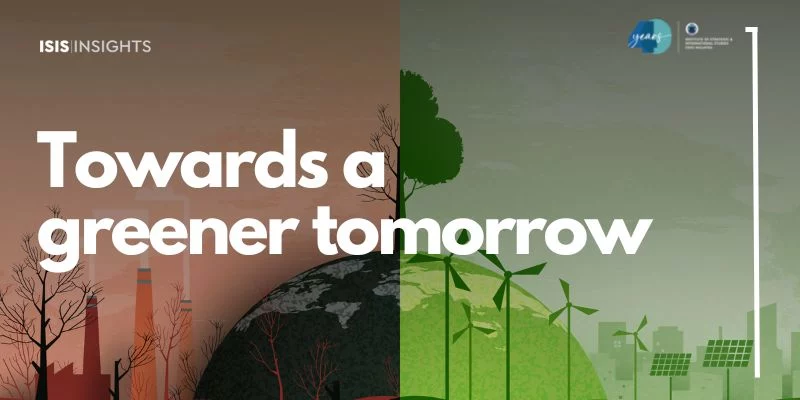IN the final quarter of 2022, two major United Nations (UN) meetings were held back to back – the UN Climate Change Conference (COP27) in Sharm el-Sheikh, Egypt, in November, and the UN Biodiversity Conference (COP15) in Montreal, Canada, in December.
COP27 was crucial for two reasons. The Ukraine war and Covid-19 forced numerous countries to resume coal-fired generations, pushing carbon emissions to record highs. The geopolitical crisis likewise exposed our susceptibility to energy shortages and the need for cultivating alternative energy sources.
Another reason was the prospect of achieving the goals of the landmark Paris Agreement of 2015. During COP21, 196 countries agreed to limit average global temperatures to well below two degrees Celsius above pre-industrial levels, ideally limited to 1.5 degrees Celsius. To meet these goals, carbon emissions must be slashed by 45% by 2030, reaching net zero by 2050. Some experts have serious doubts about whether these goals can be achieved.
COP15 of the Convention on Biological Diversity was nothing short of historic as nations came together to adopt the Kunming-Montreal Global Biodiversity Framework (GBF), which provides a strategic vision and a global roadmap for the conservation, sustainable use and restoration of biodiversity for the next decade.
The centrepiece of the agreement is to protect 30% of Earth’s lands, oceans, coastal areas and inland waters by 2030. Without such action, there will be a further acceleration in the global rate of species extinction.
The meeting on climate change drew the attendance of over 35,000 participants comprising more than 100 heads of state and governments involved in high-level and side events, key negotiations, and press conferences.
There were also numerous pavilions showcasing climate action around the world, including Malaysia, and across different sectors.
The COP15 biodiversity meeting was attended by 20,000 people from around the world. Although biodiversity loss is as serious as global warming, the issue has never been seen to be on the same par with the latter.
Except for the Prime Minister of the host country Justin Trudeau, no other world leaders attended the meeting. Participants included political leaders, indigenous leaders, scientists, academics, environmentalists, the business community, and non-governmental organisations.
During these mega-meetings, the limelight has always been shone on the negotiators, many of whom are career diplomats, legal experts and senior civil servants.
However, the corpus of knowledge on these issues normally originates from researchers in the universities and research institutions through their lifelong work.
The challenge is how this scientific knowledge could be packaged into something practical and be of use to humankind.
To illustrate, here is an anecdote about how science can influence environmental policy.
In May 1985, Nature published a paper by British scientists revealing that over Antarctica, a hole had formed in the ozone layer, the component of the atmosphere that is crucial in shielding humans from the sun’s cancer-causing ultraviolet rays.
At the time, environmental policy was not a priority for the United States president Ronald Reagan and his advisers – at least not until Reagan had a cancerous growth on the right side of his nose removed three months after that historic study on the hole in the ozone layer.
Between that surgery and his love for the great outdoors, the president may have been able to see how it all related to the ozone hole. Eventually, he got behind the idea of a treaty to phase out chlorofluorocarbons (CFCs), the compound linked to the atmospheric damage.
In 1987, the US and about two dozen nations signed the Montreal Protocol; the world’s first-ever global treaty to reduce pollution and phase out CFCs.
Scientists say the damage to the ozone layer has been healing, and that the hole could close when we enter the 2060s.
In recent times, the establishment of the Intergovernmental Panel on Climate Change (IPCC) in 1988 has all the ingredients of an enthralling story of how science prompted the international community to act on an existential issue facing humankind.
The IPCC was mandated to provide policymakers with regular scientific assessments on the current state of knowledge about climate change. It played a key role in the creation of the UN Framework Convention on Climate Change (UNFCCC), the international treaty to reduce global warming and cope with the consequences of climate change.
Science is also the bedrock in the establishment of the Intergovernmental Platform on Biodiversity and Ecosystem Services (IPBES) in 2012. Its mission is to provide policymakers with scientific advice to halt biodiversity loss. It’s 2019 landmark assessment which declared that up to one million species of plants and animals were under threat of extinction was one of the catalysts that resulted in the adoption of the GBF outlined above.
The science-policy nexus – the dialogue that needs to happen between the scientific community and our political leaders and decision makers – is also the raison d’etre for the establishment of the International Institute on Science Diplomacy and Sustainability (IISDS) at UCSI University.
This article first appeared on Star Online on 8 Jan 2023





